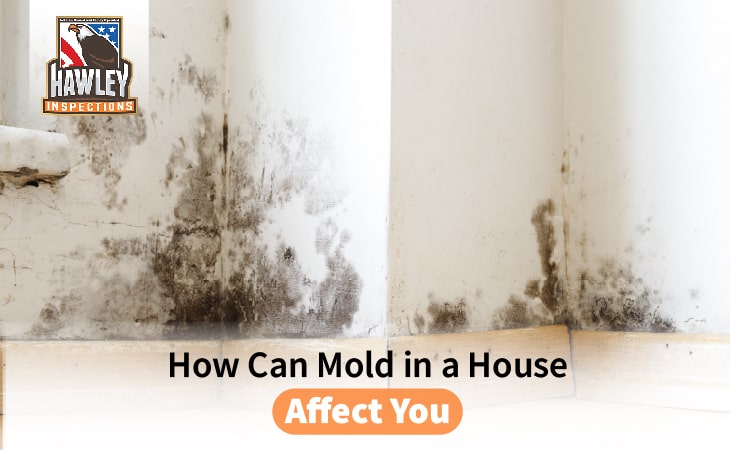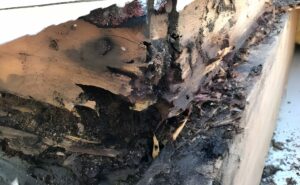
How Can Mold in a House Affect You
Introduction
Mold is a common nuisance that seems harmless at first sight. But it has the capacity to literally eat away your home. This little type of fungus is to blame for 21% of asthma cases in the U.S., according to WHO. The interesting fact is it feeds on EVERYTHING, and you’ll notice the most fatal type of mold residing in your kitchen. Whether it’s behind the walls or in the basement and bathroom, no area of your home is safe from mold growth. Besides putting your family’s health at stake, it can also drop your home’s value by a great margin.
This is why Hawley Inspections is here to spread awareness regarding mold and its dangers. We will guide you on how can mold in a house affect you. This blog is your ultimate guide to learning about mold problems in homes. By the end of this blog, you’ll also get to know the obvious signs of mold attack so you can better watch out for them.
So, without further ado, let’s get into it.
Dangers of Mold
Mold problems in homes could be adverse, whether it’s about damaging your health or the home’s structure.
Starting off, you’ll notice constant health concerns like allergies, respiratory issues, heavy breathing, and asthma attacks. The extended mold exposure can be a stumbling block to your fitness. It may also damage your immune system and make you susceptible to other viruses and diseases.
Apart from that, mold is a red signal for your home’s safety and marketability. It can wreck your drywall and wooden structures. And also compromise your home’s foundation. This will make you repair repetitively and spend a fortune on that. This results in poor safety features, unpleasant curb appeal, and reduced resale value.
Let’s get into each of the mold dangers in turn.
How Can Mold in a House Affect You?
Your health can be directly influenced by mold exposure. Contacting with mold for a prolonged time can cause several diseases, including allergic reactions, respiratory issues, asthma attacks, nasal congestion, and more. Let’s indulge in each one
Respiratory Issues
Mold can be an obvious reason for your respiratory issues. If you’ve been facing heavy breathing or shortage of breathing, wheezing, or coughing – mold is to look for. As per WHO report, 30-50% of increases have been noticed in respiratory diseases caused by mold.
Allergic Reactions
Mold and its spores are tiny and can be inhaled through air. They grow in vents, ducts, HVAC, and other components through which they easily travel and breathe into your lungs. This triggers allergic reactions such as runny nose, itchy eyes, skin irritation, sneezing, and more.
Asthma Attack
If you’re already suffering from asthma, mold can be a triggering element to breathe. It may cause coughing, wheezing, irritated or inflamed airways, shortness of breath, chest tightness, and even worse. Extended mold exposure may lead to you needing emergency medical help. As per EPA, about 4.6 million asthma cases are caused due to mold.
Fungal Infections
People with weakened immune systems can fall prey to fungal infections. Maybe your home is under mold attack, and you didn’t notice. This leads to poor indoor air quality, causing fungal infection in your lungs.
Hypersensitivity Pneumonitis
Living in molded indoors can cause hypersensitivity pneumonitis. It is a lung inflammation that gets triggered by inhaling dust or mold, leading to an allergic reaction. This condition also causes fever, cough, and breathing problems.
Mold Problems in Homes
Mold can reside in the kitchen, bathroom, basement, ceilings, floors, behind the walls, and any other corner of your home. It doesn’t even spare your home components and can make their colonies into vents, ducts, HVACs, air conditioners, and others.
Mold can damage your home structures, such as wooden furniture, and cause warping, rotting, and decay. And what’s more interesting is that it can feed on anything your home has. Mold will not only weaken your home’s structures but also affect your home’s curb appeal and marketability.
Weak Structures
Your home components can decay over time due to mold growth. For instance, wooden furniture, shingles, and more. The home’s structures can also drop their strength and shine due to mold proliferation.
Insulation Problem
When the HVAC, air conditioning, ducts, and vents are subject to mold attack, you may notice insulation problems. The mold travels through the air into the HVAC system, polluting indoor air quality. It will not only decay the insulation but also clog the air ducts or coils.
Drywall Damage
Mold could be hidden behind your drywall. It can cause water leaks and moisture damage to your drywalls. Ultimately, the drywall structure will get stained, crumbled, or softened. The damage could spread to the extent that you’ll have to replace your drywall.
Property Curb Appeal
When mold patches are present on the walls, ceilings, and floors, it will damage your home’s curb appeal. Besides damaging your home’s theme, it will influence the existing home’s aesthetics. And negatively impact your home’s outlook for the future as well.
Property Value
As per the Appraisal Journal research, a home’s market value can be reduced from 20% to 37% due to its mold issues. It’s commonly understood that no one would want to buy a home under a mold attack. Whether you’re buying a home with mold or selling your own – the home value would be significantly compromised.
However, if you choose a mold inspection timely, you can save your property from depreciation. Getting a professional mold inspector on your service will identify existing and potential problems. He will also give you suggestions to avoid mold problems in homes.
Signs of Mold Damages
Now, you must have understood how mold damages your health, property’s appeal, and marketability. It’s high time we take you through the signs of mold damage. By knowing these signs, you can detect and prevent mold attacks. Moreover, you can also determine the right time to call for a mold inspection company like Hawley Inspections. So here are some signs of mold problems in homes.
Odor
If you constantly notice a musty odor in your room, kitchen, bathroom, or basement, beware! It’s the first sign that your home definitely hosts mold and its spores. Smelling these musty odors, call a professional right away.
Visible Mold
Mold could be hidden, but it’s big enough to get noticed by the naked eye. Therefore, when you notice stains or discoloration of walls, then look for mold patches. Molds are of different types and colors. It could be black or green. So, you can identify it by appearance.
Water Leaks
The water leaks in your home create the best condition for mold to grow. Whenever you notice moisture damage or water leaks anywhere in your home, understand that mold will definitely grow here. Therefore, you should take the necessary preps before time. And you can also reach out to a professional to take a proactive approach.
Conclusion
Mold is one of the most dangerous elements affecting your home’s indoor air quality. It cannot only influence your health but also damage your property’s curb appeal and market value.
We discussed how can mold in a house affect you, whether it’s about the health of your family or the marketability of your home. Moreover, we also revealed the signs of mold damage so you can avoid mold problems in your homes beforehand.
Stay tuned to get more informative blogs.




